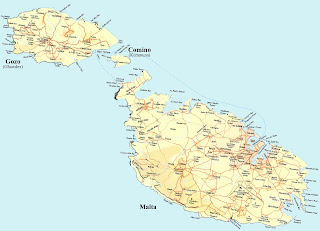CASE 448 - The history of Malta
Malta, officially known as the Republic of Malta is a Southern European island country consisting of an archipelago in the Mediterranean Sea. It lies 80 km (50 mi) south of Italy, 284 km (176 mi) east of Tunisia and 333 km (207 mi) north of Libya. The country covers just over 316 km2 (122 sq mi), with a population of just under 450,000,[3] making it one of the world's smallest and most densely populated countries. The capital of Malta is Valletta, which at 0.8 km2, is the smallest national capital in the European Union. Malta has two official languages: Maltese and English. Malta's location has historically given it great strategic importance as a naval base, and a succession of powers, including the Phoenicians, Carthaginians, Romans, Moors, Normans, Sicilians, Spanish, Knights of St. John, Knights of Malta, French and British, have ruled the islands.
King George VI of the United Kingdom awarded the George Cross to Malta in 1942 for the country's bravery in the Second World War. The George Cross continues to appear on Malta's national flag. Under the Malta Independence Act, passed by the British Parliament in 1964, Malta gained independence from the United Kingdom as an independent sovereign Commonwealth realm, officially known from 1964 to 1974 as the State of Malta, with Elizabeth II as its head of state. The country became a republic in 1974, and although no longer a Commonwealth realm, remains a current member state of the Commonwealth of Nations. Malta was admitted to the United Nations in 1964 and to the European Union in 2004; in 2008, it became part of the Eurozone.
Malta has a long Christian legacy and its Archdiocese of Malta is claimed to be an apostolic see because, according to tradition dating to around the 12th century, the Acts of the Apostles is interpreted by the faithful that St Paul was shipwrecked on Malta. Catholicism is the official religion in Malta.
The history of Malta is a long and colourful one dating back to the dawn of civilisation. The Maltese Islands went through a golden Neolithic period, the remains of which are the mysterious temples dedicated to the goddess of fertility. Later on, the Phoenicians, the Carthaginians, the Romans and the Byzantines, all left their traces on the Islands. In 60 A.D. St. Paul was shipwrecked on the island while on his way to Rome and brought Christianity to Malta. The Arabs conquered the islands in 870 A.D. and left an important mark on the language of the Maltese. Until 1530 Malta was an extension of Sicily: The Normans, the Aragonese and other conquerors who ruled over Sicily also governed the Maltese Islands. It was Charles V who bequeathed Malta to the Sovereign Military Order of St. John of Jerusalem who ruled over Malta from 1530 to 1798. The Knights took Malta through a new golden age, making it a key player in the cultural scene of 17th and 18th century Europe. The artistic and cultural lives of the Maltese Islands were injected with the presence of artists such as Caravaggio, Mattia Preti and Favray who were commissioned by the Knights to embellish churches, palaces and auberges.
In 1798, Napoleon Bonaparte took over Malta from the Knights on his way to Egypt. The French presence on the islands was short lived, as the English, who were requested by the Maltese to help them against the French, blockaded the islands in 1800.
British rule in Malta lasted until 1964 when Malta became independent. The Maltese adapted the British system of administration, education and legislation.
Modern Malta became a Republic in 1974 and joined the European Union in May 2004.
Not to be mistaken with the:
(CASE 106 - The Sovereign Military Order of Malta)


